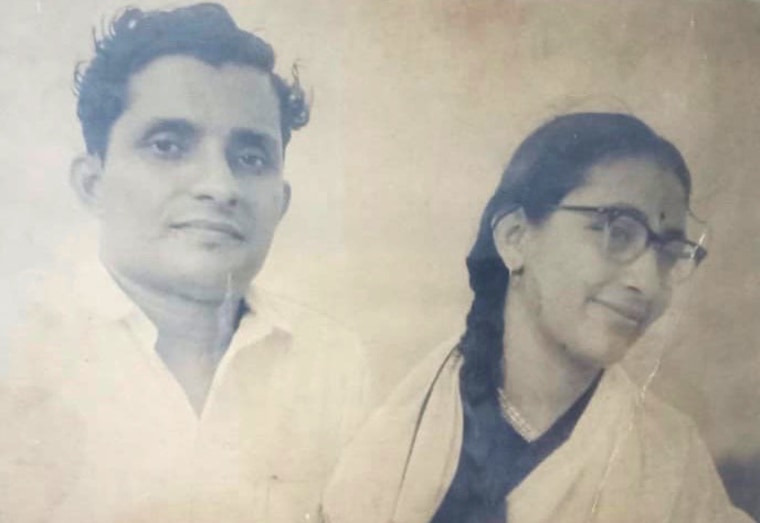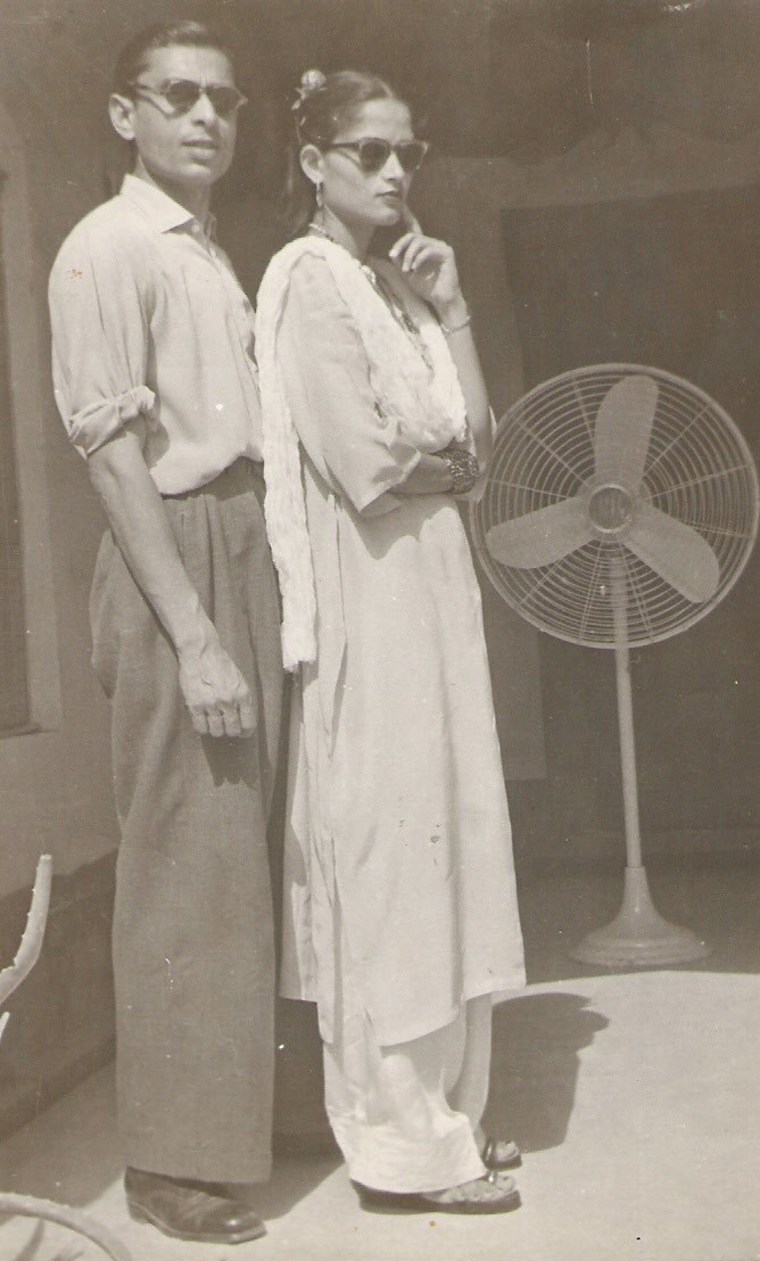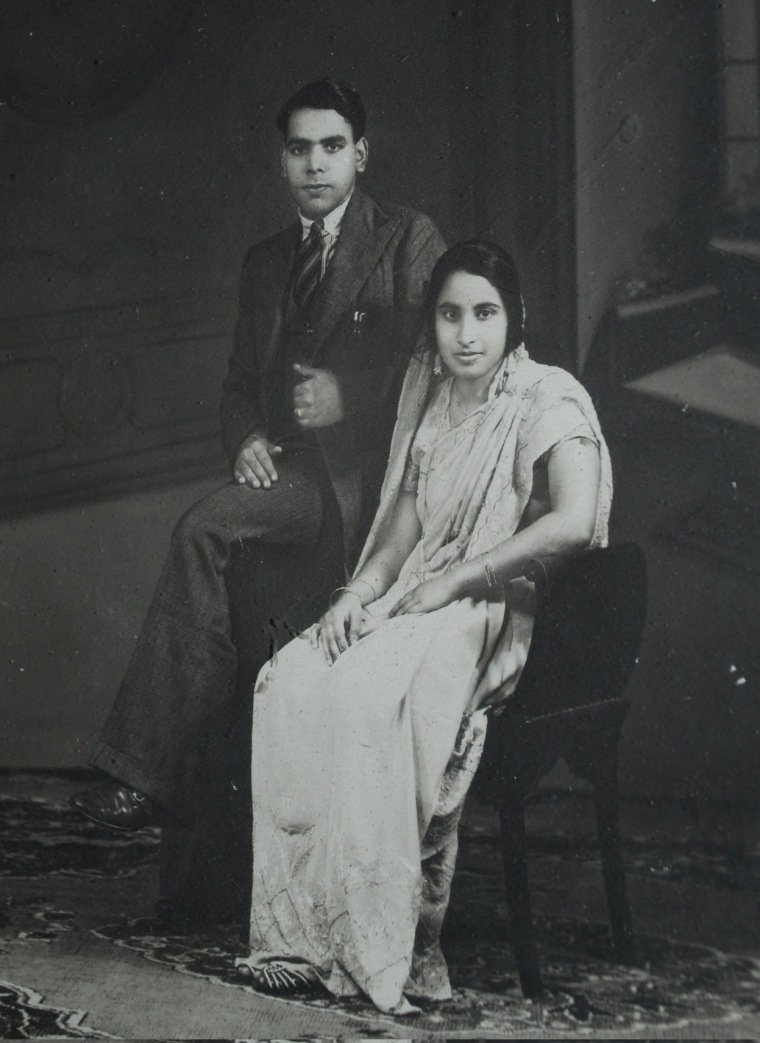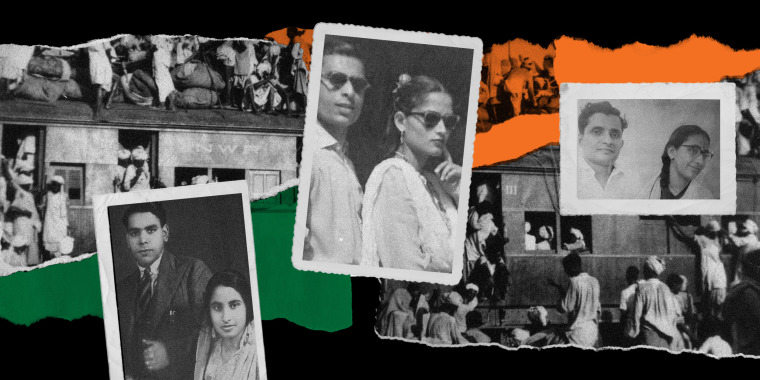Ankita Mukhopadhyay always knew there was pain in her grandfather’s past. As a kid, she didn’t understand the depth of it, but she heard his stories about 1947. Families pushed from the rooftops of houses, bodies in the street. Unable to return to his home in what is now Bangladesh after the partition, he carried a lifelong sadness with him that she couldn’t quite explain.
“I used to send him letters in English. He used to tear apart my letters in front of me and say, ‘This is the language of our colonizers. I do not want you to write letters to me in the language of my colonizer,’” she recounted to NBC Asian America.
Now 29 and living in the San Francisco Bay Area, Mukhopadhyay is far removed in time and distance from the India-Pakistan partition. But 1947’s violence has shaped lives, and its impacts still linger in the South Asian diaspora.

Parents and grandparents who survived it have shared their stories, and 75 years later, a dwindling group of South Asians remembers the events of that time period. Their American children, though, say the memories won’t be lost. The harshest realities of their family members’ lives have been passed down to them for generations — ingrained over dinner or during a TV show.
“The partition was a constant part of our lives,” said Mukhopadhyay, who was born and raised in India. “My grandfather used to always say, ‘I’m not Indian. I lost everything, and there’s no concept of India.’”
The deadliest event in South Asian history
On midnight between Aug. 14 and 15, 1947, British-ruled India was divided into two states: a Muslim-dominated Pakistan and Hindu-dominated India. It also separated the provinces of Bengal and Punjab along religious lines despite the diversity of the two provinces. The British government’s hasty exodus from the region was a catalyst for a violent and chaotic migration between the two new countries: There were 500,000 to 2 million deaths, and 15 million South Asians were displaced.
According to experts, it has affected not only which South Asians get to be in the U.S. but how they are received when they get here. Countries with closer ties to the U.S. tend to be favored when it comes to immigration, said Hardeep Dhillon, a legal historian specializing in global migration. This has mostly benefited Indians, whose numbers began to increase after the Immigration and Naturalization Act of 1964.
Islamophobia, perpetuated by legislation in the U.S. and India, is one of the ways the partition deepened divides across the world, Dhillon said.
“Partition has impacted the way in which different South Asian American communities view one another,” she said. “In some cases, the memories and histories of partition animate diasporic differences and hate.”
Dhillon says stories about the partition often slip through the cracks once families leave the subcontinent.
“In the diaspora, especially where the focus is on the immigrant’s narrative rather than the history of one’s ancestral homeland, histories of partition have slipped to the margins of family history and public memory,” she said.
‘We have no nation’
Partition-related violence turned her previously middle-class family into refugees, Mukhopadhyay said. Her grandparents longed to go back to see their old houses in Bangladesh. But they died before they were able to.
The trauma of surviving and losing everything meant an anxiety and anger that her grandparents projected onto her, she said.
“My dad’s parents, because they had such a violent past, it sort of permeated down to my family’s experience and the way I was brought up,” she said. “They were very bitter people, but not by choice.”
Growing up in Oklahoma, the Pakistani American experience became distinct for Sana Masood, 30, after 9/11. She felt the urge to lose her culture in the white people around her, and so she didn’t ask about her family’s partition story beyond what she already knew.
Her grandfather, who died when she was in college, was a teenager during the partition and crossed with his family from Haryana, India, to Karachi, Pakistan, where Masood and her parents were born.
It wasn’t until earlier this year that decades of locked-up stories slowly began to flow out of her father.
“I heard from my dad about how, since they were from Punjab, they never really fit in when they came over to Pakistan,” she said. “They were always kind of told they didn’t belong since they had come from India. I know that has some lasting effects on my dad.”

It’s an experience she can relate to, she found. The sense of being an outsider in the only country she’s ever known is a common thread between three generations of her family: her grandfather’s life, her father’s life and her own. She was bullied in grade school for being brown, and her family members were made to feel as if they didn’t have a place in the U.S.
“The general racism, Islamophobia that we’ve experienced being in the South, especially with 9/11, and being told ‘You don’t belong.’ My dad’s just kind of like, ‘I’ve been told that my whole life,’” she said.
Her father’s experiences have left him feeling lost, she said, and unanchored to any particular country.
“I think at the end of the day, it kind of makes him feel like he has no nation, or no nationality,” she said. “Because wherever he has been, wherever he has lived, he has felt like he has not fit in.”
‘I am Indian, Bangladeshi and Pakistani’
When Sara Kapadia, 42, tries to explain her ethnicity, there are three possible answers she could give.
“My mom is from Bangladesh, and my dad was from Pakistan, but they were both born in India,” she said. “I just call myself South Asian.”

Throughout her life, the current Los Angeles resident has been forced to face the reality of why this is: Seventy-five years ago, her grandfather was killed, and the family of her mother, who was then a 2-year-old, had to flee their home in Delhi for Bangladesh.
Her mother, Munni Kapadia, 77, told NBC Asian America that she was too young to remember the partition, but she still feels its impacts. Munni’s father left the house one morning to pick up medicine for her younger brother. Before he could return, he was attacked and killed.
He had talked openly about wanting to leave India for Pakistan, Munni said. In doing so, he made enemies.
“We were in refugee camps for three months,” she said. After being discovered there by a Bengali military leader and family friend, Muhammad Ataul Goni Osmani, they were able to cross into what was then East Pakistan, now Bangladesh.
Munni’s mother, who was a widow at 25, took charge of the family, she said, and got a degree in medicine to support them. Her cousin later became a Bangladeshi freedom fighter during the 1960s before before the nation became independent in 1971.
Munni met her husband while studying in London on a scholarship. He was also born in India and moved to Pakistan as a young child. They had a love marriage, and her daughter, Sara, was born at the crux of three identities.
“My dad would speak to my mom in Urdu and my mom would speak to me in Bangla,” she said.
In college at the University of Cambridge, Kapadia became a leading member of both the Bangladeshi and Pakistani students’ associations. The two, along with the Indian students association, had friendly rivalries, she said. But when it came to talking about the partition, things would sometimes take a turn.
“Sometimes, things would get really nasty,” she said. “Students from Pakistan and Bangladesh and India would argue over cricket and politics. I never took sides. I have family all over South Asia."
New pop-culture references
Modern media is helping to archive the collective trauma of the partition and bring it to a new generation, Dhillon, the global migration specialist, said.
“Ms. Marvel,” for example, a Disney+ series featuring a Pakistani superhero, shared some of these narratives with a global audience this year. The show re-enacts the partition as a main part of the main character’s backstory, including scenes of migration trains, refugee resettlement and the longer-lasting effects of generational trauma.
For Masood, who says she regrets not asking her grandfather more about his life, “Ms. Marvel” has been a gateway into learning about her family’s history. Watching it with her parents, she says she could see them physically open up when they saw their stories represented on screen.
“It was during those partition episodes that I got the most information I ever had,” she said. “At first, it was just really great to see our culture, things we can actually relate to, on a deeper level on a TV show. And then when it got to the episodes of the partition, I felt a really striking emotion seeing that because, that’s what my family had to go through. It wasn’t an abstract concept of history. This actually directly impacted me.”
A new generation left with their families’ stories
As the anniversary of the partition comes each year, fewer South Asians have a firsthand memory of its horrors. Many will die with their stories, said Dhillon, as fear of ostracization has kept many silent.
Partition survivors’ relatives in the diaspora say the generational trauma is still present, but a chance for healing comes in acknowledging their pain.
Mukhopadhyay believes that Bengali stories from that time period have been buried more than others. Movies about the partition usually focus on people traveling between major cities in India and Pakistan, she said, and Bangladesh is left out of the narrative.
“I feel like our pain, the Bengali side, isn’t talked about that often,” she said. “We should get more representation.”
If things had played out differently 75 years ago, Mukhopadhyay ponders what her life might look like now.
“My family lost everything because of this event,” she said. “Maybe things would have been much different if we hadn’t been partitioned. So I feel the pain. This affects everything in our lives.”

